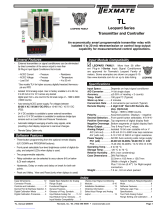
-3-
Released 2018-01-19 Drawing No. LP0722
3.0 WIrIng the Meter
EMC INSTALLATION GUIDELINES
Although Red Lion Controls products are designed with a high degree
of immunity to Electromagnetic Interference (EMI), proper installation
and wiring methods must be followed to ensure compatibility in each
application. The type of the electrical noise, source or coupling method
into a unit may be different for various installations. Cable length, routing,
and shield termination are very important and can mean the difference
between a successful or troublesome installation. Listed are some EMI
guidelines for a successful installation in an industrial environment.
1. A unit should be mounted in a metal enclosure, which is properly
connected to protective earth.
2. Use shielded cables for all Signal and Control inputs. The shield
connection should be made as short as possible. The connection point
for the shield depends somewhat upon the application. Listed below
are the recommended methods of connecting the shield, in order of
their effectiveness.
a. Connect the shield to earth ground (protective earth) at one end
where the unit is mounted.
b. Connect the shield to earth ground at both ends of the cable, usually
when the noise source frequency is over 1 MHz.
3. Never run Signal or Control cables in the same conduit or raceway
with AC power lines, conductors, feeding motors, solenoids, SCR
controls, and heaters, etc. The cables should be run through metal
conduit that is properly grounded. This is especially useful in
applications where cable runs are long and portable two-way radios
are used in close proximity or if the installation is near a commercial
radio transmitter. Also, Signal or Control cables within an enclosure
should be routed as far away as possible from contactors, control
relays, transformers, and other noisy components.
4. Long cable runs are more susceptible to EMI pickup than short cable
runs.
5. In extremely high EMI environments, the use of external EMI
suppression devices such as Ferrite Suppression Cores for signal and
control cables is effective. The following EMI suppression devices (or
equivalent) are recommended:
Fair-Rite part number 0443167251 (Red Lion Controls #FCOR0000)
Line Filters for input power cables:
Schaffner # FN2010-1/07 (Red Lion Controls #LFIL0000)
6. To protect relay contacts that control inductive loads and to minimize
radiated and conducted noise (EMI), some type of contact protection
network is normally installed across the load, the contacts or both. The
most effective location is across the load.
a. Using a snubber, which is a resistor-capacitor (RC) network or metal
oxide varistor (MOV) across an AC inductive load is very effective at
reducing EMI and increasing relay contact life.
b. If a DC inductive load (such as a DC relay coil) is controlled by a
transistor switch, care must be taken not to exceed the breakdown
voltage of the transistor when the load is switched. One of the most
effective ways is to place a diode across the inductive load. Most
Red Lion products with solid state outputs have internal zener diode
protection. However external diode protection at the load is always
a good design practice to limit EMI. Although the use of a snubber
or varistor could be used.
Red Lion part numbers: Snubber: SNUB0000
Varistor: ILS11500 or ILS23000
7. Care should be taken when connecting input and output devices to the
instrument. When a separate input and output common is provided,
they should not be mixed. Therefore a sensor common should NOT be
connected to an output common. This would cause EMI on the
sensitive input common, which could affect the instrument’s operation.
Visit http://www.redlion.net/emi for more information on EMI guidelines,
Safety and CE issues as they relate to Red Lion products.
WIRING OVERVIEW
Electrical connections are made via screw-clamp terminals located on
the back of the meter. All conductors should conform to the meter’s
voltage and current ratings. All cabling should conform to appropriate
standards of good installation, local codes and regulations. It is
recommended that the power supplied to the meter (DC or AC) be
protected by a fuse or circuit breaker.
When wiring the meter, compare the numbers embossed on the back
of the meter case against those shown in wiring drawings for proper wire
position. Strip the wire, leaving approximately 0.3" (7.5 mm) bare lead
exposed (stranded wires should be tinned with solder.) Insert the lead
under the correct screw-clamp terminal and tighten until the wire is
secure. (Pull wire to verify tightness.)
INPUT RANGE JUMPER
This jumper is used to select the proper input range. The input range
selected in programming must match the jumper setting. Select a range
that is high enough to accommodate the maximum signal input to avoid
overloads.
To access the jumpers, remove the meter base from the case by firmly
squeezing and pulling back on the side rear finger tabs. This should
lower the latch below the case slot (which is located just in front of the
finger tabs). It is recommended to release the latch on one side, then
start on the other side latch.
Warning: Exposed line voltage exists on the circuit boards.
Remove all power to the meter and load circuits before
accessing inside of the meter.
2.0 settIng the JuMpers
INPUT RANGE
JUMPER LOCATION
Main
Circuit
Board
REAR TERMINALS
FRONT DISPLAY
VOLT
CURRENT
200 mA
2 mA
20 mA
200 µA
10 V
200 mV/2 V
20 V/200 V
VOLT
CURRENT
REAR TERMINALS
INPUT
RANGES












